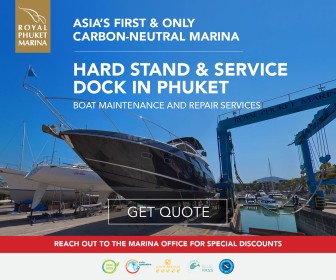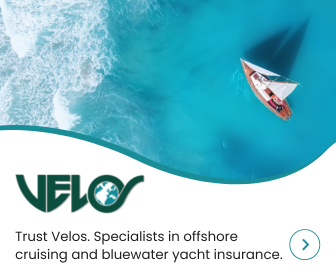Adam’s Bridge Conquered
Published 14 years ago, updated 6 years ago
Sent by Bill Webb from Yacht “Out of the Bag” – a Bob Oram 44C designed catamaran.
Posted 15 April 2011
Ever since setting out to sail the world, I have always wondered why yachts always took the long course around Sri Lanka after departing Thailand or Malaysia on the way to Maldives Islands, thence on to the Red Sea. Why not sail between India and Sri Lanka to save time? It was with disbelief that when I enquired, I was told that the passage between the two countries was blocked by an impassable barrier known as Adam’s Bridge, an area of shallow and treacherous sandbars with pounding seas. “You have got to be kidding”, was my first remark.
Anyhow, some three years after this great revelation, I decided that seeing that I was in India, being the first sailing yacht to officially visit Chennai, and of course the first multihull yacht, that I would take the time to discover the secrets of Palk Bay and Palk Passage, the home of Adams Bridge.
Following a sail from Chennai, OOTB reached the entrance to Palk Bay inside 24-hours; the distance being some 175-miles. It was a further 72 miles direct through both Indian and Sri Lankan waters to Land’s End, an area I had selected for the crossing. Not sure why this area was selected but it appealed to me. Some 25-miles away from Land’s End and north-west was an area where I was told there was an opening rail bridge through which passage may possibly be found with the assistance of the rail-bridge operator, a pilot and calm weather. This was to be my back up plan should the first attempt at the crossing at Land’s End fail.
On the way to Lands End, we were paid a visit by a very well maintained Sri Lankan warship, bristling with cannon. They called us up and were very courteous, even advising that Sri Lanka had won their World Cup final berth by beating England in a semi-final the night before. When I advised my plan to cross Adam’s Bridge, an incredulous tone could be interpreted in the radio operator’s voice: “Please confirm, you intend to cross the sandbar?” was his reply. “Romeo,” I responded. That this was indeed our mission, conditions permitting.
We arrived at Lands End on Sunday night, 27th March 2011, to calm conditions at high tide albeit only a 0.6 tide that day, but too late to have good visibility of the bar and to note the route and wave conditions throughout. It was decided to anchor overnight and give the crossing a try the following morning. But of course, we did not allow for Murphy’s Law! The wind blew in quite strongly from the East at around 2230 hours, placing “Out of the Bag” on a lee shore and in very choppy conditions.
Nothing left to do but up anchor and head back to a little island, Kachchaitivu Island, we had passed earlier on some 13-miles away in Sri Lankan territory. The island offered good shelter and good holding in the sand so we slept well. The whole of Palk Bay is no more than 13 metres deep so the bay apparently does become quite choppy in a strong blow. In retrospect, we probably should have stopped the night at Kachchaitivu when passing, rather than racing onwards to see the bar crossing before dark.
Our friendly Sri Lankan warship was nearby as we headed off next morning on Monday 28th March 2011. After we raised anchor at 7:15 am, the warship called us up on the radio to inquire what was happening, to which we replied that the bar was too rough the night before. The warship’s reply was of the order of “Good luck”. A tone of sarcasm was detected but ignored.
On arriving back at Land’s End, we immediately anchored close to Pamban Island (Land’s End) and took the dingy to test sound the depths and search for a passage through. Having completed this procedure it was time to head off and out to sea. There was a constant brake on the bar, but of no real significance: we comforted ourselves in the fact that this was merely a ripple when you compare it to say Wide Bay Bar back home in Australia. However, the depths here were considerably shallower than any of those bars back home.
“Out of the Bag”, skippered by Bill Webb with Gene Stuart as crew, (both members of Magnetic Island Yacht Club), made the crossing at a location know as “Land’s End”. This shallow strip of water is at the southern tip of the Indian border where India and Sri Lanka meet. Land’s End is at the extremity of Pamban Island on the Indian side of Adam’s Bridge. This island is of religious significance to followers of the Hindu faith. It is an area where there is neither a marked channel nor other boats to follow. Watched by a group of around 50 holidaymakers and religious pilgrims (we hoped their prayers were for us), the crossing took place at 10:30 am. “Out of the Bag” crossed with little fuss even though the depths with breaking water at times were less than 1 metre over the 1/2-mile transit. Once clear over the bar, it was high-fives all round between Bill and Gene as the challenge of the bar crossing had been met and passed without any groundings or bottom touching. “Out of the Bag” had achieved what we came here to do – cross Adam’s Bridge.
All that was left was to set the auto-pilot for the transit through the Gulf of Mannar. Next stop Maldives Islands some 470-miles away.
“Out of the Bag” became the first ever sail vessel to cross Adam’s Bridge unaided, certainly the first multihull. An account from pre-war times has been documented in The Indian Ocean Cruising Guide written by Rod Heikell. It describes the passage as being very difficult as shifting sandbanks makes the crossing “not at all straightforward”. However, the previous crossing referred to in that Cruising Guide was with the assistance of a pilot and via an opening railway bridge.
Sent by Jean Francois Cormerais
Posted 29 June 2011
I sailed through Adam bridge from Tuticorin (India) towards Trincomalee (Sri Lanka)in 1982. My boat was steel, a 33 footer named “Courlis”. It was just before the massacre of Tamil peoples.
It was difficult before, indeed, not so many had been doing so. However, there was a bridge near the coast of Sri Lanka supporting the train. I guess that this turning bridge was to allow local crafts to sail through.
Thirty years ago I sailed through. I do not know if I was the first because it was not my main purpose. It was a great trip even if difficult for navigation because of no chart etc..




